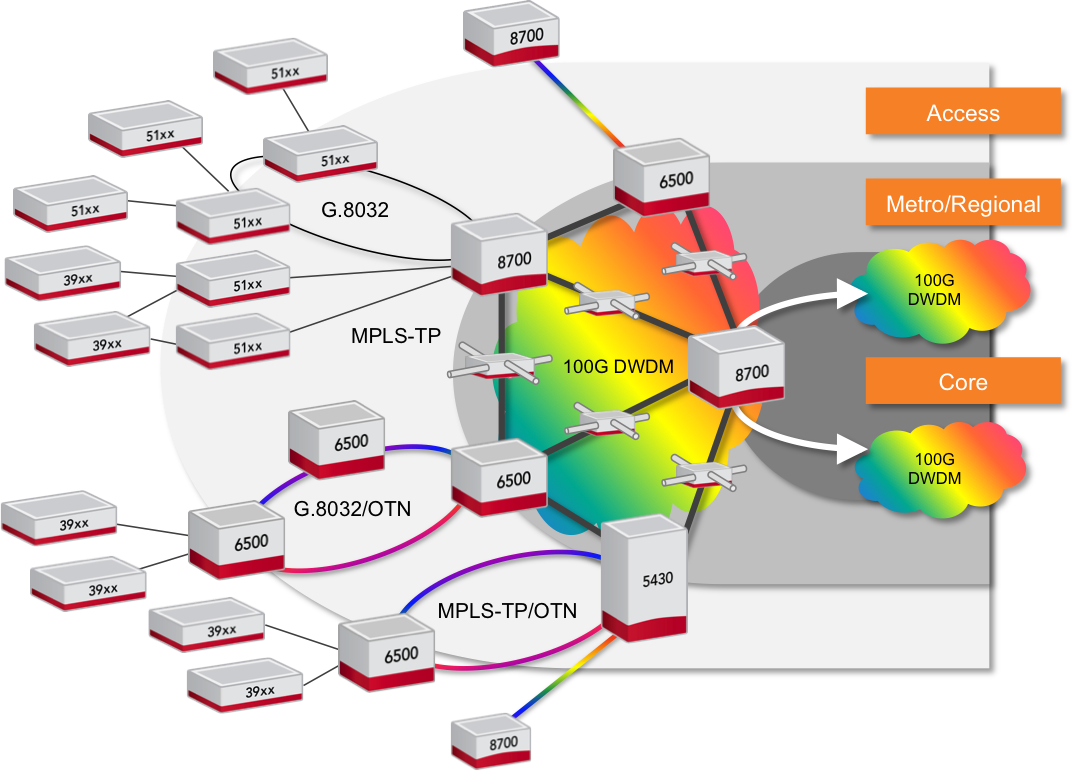Ciena launches the 8700 metro Ethernet-over-WDM platform
 Wednesday, June 18, 2014 at 4:58PM
Wednesday, June 18, 2014 at 4:58PM
- The 8700 Packetwave is an Ethernet-over-DWDM platform
- The 8700 is claimed to deliver double the Ethernet density while halving the power consumption and space required.
 Source: Ciena
Source: Ciena
Ciena has launched the 8700 Packetwave platform that combines high-capacity Ethernet switching with 100 Gigabit coherent optical transmission.
The platform is designed to cater for the significant growth in metro traffic, estimated at between 30 and 50 percent each year, and the ongoing shift from legacy to Ethernet services.
Brian Lavallée
Analysts predict that by 2017, 75 percent of the overall bandwidth in the metro will be Ethernet-based.
"In the major markets we compete in, our customers are telling us that Ethernet has already surpassed 75 percent," says Brian Lavallée, director of technology & solutions marketing at Ciena.
"What you're seeing is a trend towards convergence," says Ray Mota, managing partner at ACG Research. "The economics make sense and it should have happened but organisational issues have caused the delay."
Many service providers have two separate groups, one for packet and another for transport. "Now, many service providers are merging the two groups, feeling the time is right, so you will see more and more converge products get more penetration," says Mota.
The 8700 can be viewed as a slimmed-down packet-optical transport system (P-OTS), tailored for Ethernet. The platform's packet features include Ethernet and MPLS-TP for connection-oriented Ethernet, while optically it has 100 Gigabit coherent WDM.
"This is a more specialised machine hitting this target spot in the aggregation networks," says Michael Howard, co-founder and principal analyst, carrier networks at Infonetics Research. "It doesn't need much MPLS, it doesn’t need OTN switching, and it doesn’t need SDH/TDM."
The main applications for the 8700 include aggregation of telcos' business services, data centre interconnect, wireless backhaul, and the distribution of cable operators' Ethernet traffic. "It [the 8700] is a good product for edge aggregation, where the bandwidth is getting cranked up," says Howard. "I see it as an Ethernet-over-DWDM platform, performing the aggregation on the customer side and the fan-in on the upstream side."
Ray MotaTwo Packetwave platforms have been announced: an 800 Gigabit full-duplex switching capacity platform and a 2-Terabit one. The platform's line cards support 10, 40 and 100 Gigabit client-side interfaces while a line-side card has two 100 Gigabit coherent interfaces based on Ciena's WaveLogic DSP-ASIC technology.
Ciena says the platform will support double the capacity when it introduces WaveLogic devices that deliver 100 and 200 Gig rates. "It has been tested," says Lavallée. "It is just a matter of changing the cards."
The 8700 is claimed to deliver double the Ethernet density compared to competing platforms, while halving the power consumption and space required. "Given it is a new category of product, we don't have a direct competitor," says Lavallée. "But when we say half the power and space, that is the average across these multiple products from competitors."
Lavallée would not detail the competitor platforms used in the comparison but Mota cites Alcatel-Lucent's 7450 and 7950 platforms, Juniper's MX and PTX platforms and Cisco's ASR 9000 as the ones likely used.
Using merchant silicon for the Ethernet switching has helped achieve greater density, as has using Ciena's own WaveLogic DSP-ASIC. "The further development we have done on our [WaveLogic] coherent optical processor does give us significant savings, not just in power but also real-estate," says Lavallée.
Being a layer-2 platform, the 8700 has none of the packet processing and specialist memory hardware requirements associated with layer-3 IP routers, also benefitting the platform's overall power consumption.
Michael HowardCiena stresses that P-OTS is not going away and that it will continue to deliver significant value for certain customers. "The biggest concern of customers is complexity," says Lavallée. "There are a lot of ways of reducing complexity in your network and some customers believe that is Ethernet-over-dense WDM."
ACG's Mota sees the launch of the 8700 as an important move by Ciena. "The metro is the hot area that needs transitioning," he says. "Many of the traditional core requirements are moving to the metro so the timing of Ciena playing in this space with a converge platform could be strategic, providing they partner well with companies like Ericsson and the network functions virtualisation software providers."
Lavallée says that with the advent of software-defined networking and the applications that make use of the technology, there is an underlying shift from the hardware towards software. But he dismisses the notion that hardware is becoming less important.
"What is lost in this whole discussion is that if you don't have a programmable piece of hardware below, you can't write these apps," says Lavallée. The 8700 hardware is programmable and there are open interfaces to access it, he says: "We have a lot of knobs and switches that the software can use."
Further reading
Paper: Ciena 8700 Packetwave platform, click here



Reader Comments